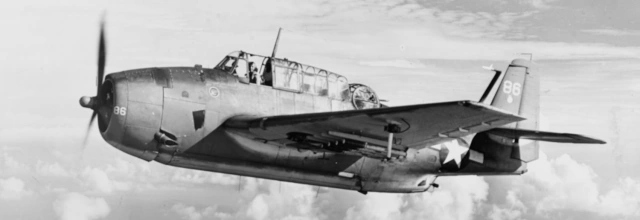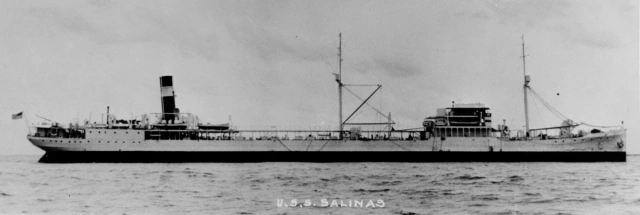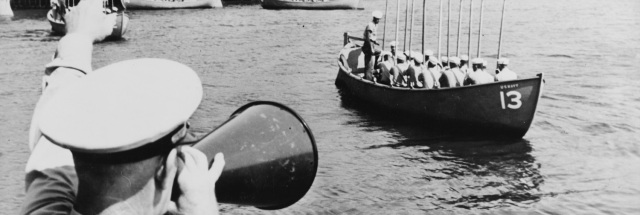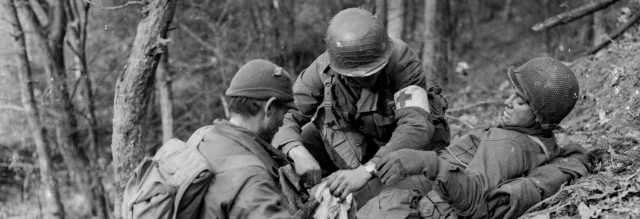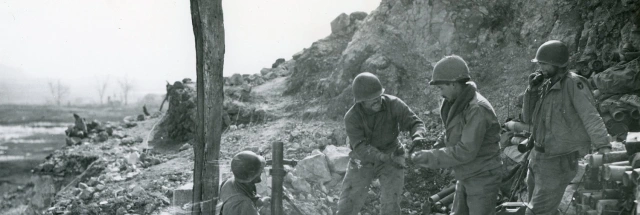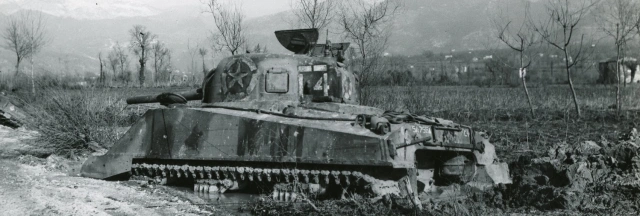
| Home State | Civilian Occupation |
| Delaware | Chauffeur |
| Branch | Service Number |
| U.S. Army | 32242886 |
| Theater | Unit |
| Pacific | Company “B,” 130th Infantry Regiment, 33rd Infantry Division |
| Military Occupational Specialty | Campaigns/Battles |
| 653 (squad leader) | Luzon |
Author’s note: This article includes adopts some narrative previously used in my article on Sergeant Philip A. Beaman, who entered the U.S. Army at the same date and location and who was assigned to the same regiment (albeit a different company).
Early Life & Family
Charles William Greer, Jr. was born in Newark, Delaware on June 12, 1920. He was the son of Charles William Greer, Sr. (a carpenter, 1891–1947) and Carrie Henrietta Greer (née Keeley, 1891–1963). He was recorded on the census on April 27, 1930 as living in Mill Creek Hundred with his parents, three older sister, two younger brothers, and paternal grandfather. (Hundreds are an old-fashioned geographic division carried over from England, which lingered in Delaware longer than other states. Mill Creek Hundred’s boundaries roughly include the area north of White Clay Creek and west of Red Clay Creek, including northern Newark, Hockessin, Milltown, and Marshallton.) Greer attended Newark High School, but his enlistment record indicates he dropped out after completing three years.
When he registered for the draft on July 1, 1941, Greer was living in Milford Crossroads in Newark. Milford Crossroads, which is part of Mill Creek Hundred, refers to the area around the intersections of Paper Mill Road, Possum Park Road, and Thompson Station Road north of downtown Newark. Greer was working for Eugene du Pont as a carpenter helper. At the time, he was described as standing five feet, 11 inches tall and weighing 145 lbs., with brown hair and gray eyes.
Greer married Mildred Alberta Takach on November 15, 1941 in Elkton, Maryland. The State of Delaware Individual Military Service Record form filled out by his wife stated that Greer was living in Christiana and working as a chauffeur before joining the military.
Training & Early Military Career
Greer was drafted shortly after the U.S. entered World War II. He went on active duty at Fort Dix, New Jersey on February 26, 1942. Shortly thereafter, he reported to Camp Forrest, Tennessee for basic training and was assigned to Company “B,” 130th Infantry Regiment, 33rd Infantry Division (known as the Golden Cross Division due to their shoulder patches). During his career, Greer reached the grade of staff sergeant, but the dates of his promotions are currently unknown. A July 12, 1945 Journal-Every Evening article stated that three of his siblings also served in the military during the war: Esther Buck (Women’s Army Corps), Grayson Greer (U.S. Army), and James Greer (U.S. Army Air Forces).
The 33rd Infantry Division moved to Fort Lewis, Washington in September 1942. In March 1943, the division was transferred to Camp Clipper at the Desert Training Center near Needles, California—a move completed in April. After further training, the division moved to Camp Stoneman, California in June 1943 and then San Francisco that same month. According to the division history, The Golden Cross: A History of The 33d Infantry Division In World War II, Greer’s regiment shipped out for Hawaii on June 22, 1943. The regiment was initially stationed in Hilo, but moved to Kauai in December for jungle and amphibious warfare training. On April 21, 1944, the 130th Infantry Regiment sailed to Honolulu to ship out for the Southwest Pacific.
After two weeks at sea, their ship arrived in Finschhafen, in eastern New Guinea. Only a small portion of the division saw combat in New Guinea; morale suffered as the division’s infantrymen found themselves consigned to months of predominantly manual labor.
In December 1944, the 130th Infantry Regiment—along with most of the 33rd Infantry Division—shipped out to the Gila Peninsula on Morotai in the Maluku Islands (part of present-day Indonesia). American forces had seized the three months earlier and built an air base to support the recapture of the Philippines.
The Japanese launched multiple air raids and managed to land a regiment on the island. The Japanese force was small and lacked heavy weapons, but still managed to fortify the thick jungle of the area referred to as Hill 40. Greer may have first seen combat on Morotai. Although the assault on Hill 40 in early January 1945 was primarily carried out by the 136th Infantry Regiment, 1st Battalion of the 130th Infantry (which included Greer’s company) supported the assault. According to Mildred Greer’s statement, Greer “Saw some action on New Guinea & Dutch E. Indies but main action started around Philippines Feb. 8, [sic] 1945”.
Combat in the Philippines
With Morotai secured, the 33rd Infantry Division shipped out to the Philippines on January 26, 1945. They began landing in Lingayen Gulf on February 10, 1945, about one month after the first American troops landed on Luzon.
According to The Golden Cross:
Before any major effort could be exerted along [the] forbidding Kennon Road it first became imperative to drive the [Japanese] from their positions on the Division’s right flank and rear. These Japanese, holed up on commanding ground, were capable of impeding supply and communication functions carried on from Division bases at Sison. With the Golden Cross gathering momentum for its northward push, it was vital that rear echelon bases be kept free from Japanese interference.
Numerous reconnaissance patrols, dispatched on Division order and manned by personnel of the 1st Battalion of the 130th Infantry, 2d Battalion of the 136th Infantry, and the 33d Cavalry Reconnaissance Troop, were pushed through the Labayug-Alibeng area with the mission of pinpointing each enemy pocket. Reports coming back to G-3 [operations staff] carried the desired information. The largest concentration of enemy troops occupied the crest of Hill 1802. The enemy garrison on 1802—a huge tree-covered mountain midway between Labayug and Alibeng—was estimated at a lone enemy rifle company reinforced by several light machine guns and mortars. Lesser Jap[anese] groups were reported on a chain of smaller hills leading into 1802.
From February 23–25, 1945, American infantry gradually eliminated Japanese positions around Hill 1802. On February 26, Staff Sergeant Greer’s battalion took up positions “several hundred yards below the crest” of the hill.
The Golden Cross described the assault against Hill 1802 on the morning of February 27, 1945:
Because of the heavily wooded terrain, it was deemed advisable to have but one company make the assault. Baker Company, led by Kentucky-born Capt. James L. Brown, was picked for the effort. […] At 0845, [Weapons Company Commander] Captain Fleming radioed his mortar positions to commence firing. In a few minutes rounds were symmetrically dotting the objective area. Baker Company inched forward to within 150 yards of the target while mortars forced the enemy to seek cover underground. At 0900 the fires lifted and the company moved out in the attack. The enemy quickly shook off the effects of the high-explosive pounding and went into an active defense. Machine guns and light mortars ripped through the trees and tore up the ground in front of Captain Brown’s men. Immediately the company spread out laterally and began to close in on the crest in a series of short rushes.
Reaching the enemy lines, “A short hand-to-hand fight followed, but every enemy attempt to stem the attack was crushed. Finally, after a systematic destruction of each hole and gun position the hill was secured.”
Staff Sergeant Greer was wounded around this time, almost certainly in the vicinity of Hill 1802. According to Mildred Greer’s statement, Staff Sergeant Greer was wounded in his leg by shrapnel on February 26, 1945 (the day before the final assault, though The Golden Cross suggested little fighting occurred that day). Mrs. Greer wrote that her husband “Died of complications resulting from wound and battle fatigue and Hepatitis” at the 43rd Field Hospital on April 12, 1945. Staff Sergeant Greer’s hospital admission card documented penetrating trauma to his ear and thigh caused by fragments from a hand grenade.
A July 12, 1945 article in Journal-Every Evening stated that
Sergeant Greer, wounded exactly three years after his induction, was believed to have recovered but had not returned to duty when complications causing his death set in, according to word received by his wife. The dead soldier’s Purple Heart is being sent to Mrs. Greer, who at present is living with her mother, Mrs. Elizabeth Takach in Christiana.
Staff Sergeant Greer’s body was buried at Fort William McKinley, now known as the Manilla American Cemetery and Memorial. Mildred Greer (1922–2008) remarried in Wilmington, Delaware on November 16, 1946, to Sergeant Greer’s brother Grayson Greer (1922–2008). The couple raised three sons.
Acknowledgments
Special thanks to the Delaware Public Archives for the use of their photo of Staff Sergeant Greer.
Bibliography
The 33d Infantry Division Historical Committee. The Golden Cross: A History of The 33d Infantry Division In World War II. Infantry Journal Press, 1948.
Delaware Marriages. Bureau of Vital Statistics, Hall of Records, Dover, Delaware. https://www.ancestry.com/imageviewer/collections/61368/images/TH-267-13198-30543-92
“Grayson Greer.” Legacy.com obituary originally from the Northern Virginia Daily, June 25, 2008. https://www.legacy.com/obituaries/nvdaily/obituary.aspx?n=grayson-greer&pid=112238070
Greer, Mildred A. Charles William Greer Individual Military Service Record, circa 1946. Record Group 1325-003-053, Record of Delawareans Who Died in World War II. Delaware Public Archives, Dover, Delaware. https://cdm16397.contentdm.oclc.org/digital/collection/p15323coll6/id/18917/rec/2
“Mildred Alberta Takach Greer.” Find a Grave. https://www.findagrave.com/memorial/143658031/mildred-alberta-greer
Silverman, Lowell. “Sergeant Philip A. Beaman (1920–1945).” https://delawarewwiifallen.com/2021/06/13/sergeant-philip-a-beaman/
“SSgt Charles William Greer Jr.” Find a Grave. https://www.findagrave.com/memorial/56775810/charles-william-greer
“State Soldier Dies on Luzon.” Journal-Every Evening, July 12, 1945. Pg. 26. https://www.newspapers.com/clip/61799414/charles-w-greer-jr/
United States of America, Bureau of the Census. Fifteenth Census of the United States, 1930. National Archives at Washington, D.C. https://www.ancestry.com/imageviewer/collections/6224/images/4531890_00702
U.S. WWII Hospital Admission Card Files, 1942-1954. Record Group 112, Records of the Office of the Surgeon General (Army), 1775–1994. National Archives at College Park, Maryland. https://www.fold3.com/record/702038192-greer-charles-w
World War II Army Enlistment Records. Record Group 64, Records of the National Archives and Records Administration. National Archives at College Park, Maryland. https://www.fold3.com/record/86107564-charles-w-greer
WWII Draft Registration Cards for Delaware, 10/16/1940-03/31/1947. Record Group 147, Records of the Selective Service System. National Archives at St. Louis, Missouri. https://www.ancestry.com/imageviewer/collections/2238/images/44003_04_00004-00297
Last updated on June 15, 2021
More stories of World War II fallen:
To have new profiles of fallen soldiers delivered to your inbox, please subscribe below.



